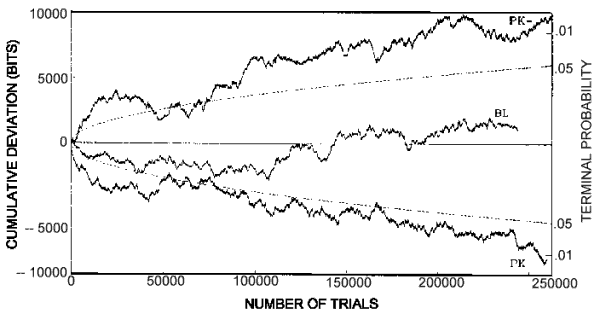 |
Science Frontiers ONLINE No. 56: Mar-Apr 1988 |
|
|
Nudging Probability
The premiere issue of the Journal of Scientific Exploration, published by the Society for Scientific Exploration, contains an excellent summary of the ESP research conducted at Princeton over the past several years. R.G. Jahn, the leader of the Princeton group, terms the research "Engineering Anomalies Research." This title is apparently more palatable to mainstream science than "Mental Influence on Electronic Devices" or "Affecting Cascading Spheres with Thought Waves." Nevertheless, most of the experimental work is in these two areas. As parapsychological research goes, the Princeton work is of the highest scientific quality.
In the first category, subjects (called operators in the report) were asked to influence the pulses produced by a Random Event Generator (REG). The REG was actually an electronic noise source coupled with circuits that created random positive and negative pulses. The operator mentally tried to increase or decrease the number of counts, or generate baseline data for experiment control. After 33 different operators and over 250,000 trials, there appeared a small but statistically significant indication that the operators were actually able to influence the equipment. Also interesting is the fact that each operator had a private "signature"; that is, individual cumulative deviation graphs (like the one shown) had typical shapes for each operator.
Related experiments were carried out with a Random Mechanical Cascade (RMC). In this device 9,000 3/4-inch polystyrene spheres cascaded down through an array of 330 nylon pegs into 19 bins. According to chance a Gaussian distribution of spheres should be found in the bins. The operators were asked to mentally try and skew the distribution to the right or left, or construct a baseline, as with the REG. Once again, there was statistically significant evidence of a mental influence.
Jahn's group also engaged in remoteviewing experiments, in which subjective factors were suppressed as far as possible. An excerpt from the report's Abstract summarizes this phase of the work nicely:
"Quantitative analysis of a large data base of remote perception experiments reveals similar departures from chance expectation of the degree of target information acquired by anomalous means. Digital scoring techniques based on a spectrum of 30 binary descriptors, applied to all targets and perceptions in the experimental pool, consistently indicate acquisition of substantial topical and impressionistic information about remote geographical locations inaccessible by known sensory channels."
In some trials, the percipient was asked to describe the remote scene even before the location was selected or visited! (Jahn, R.C., et al; "Engineering Anomalies Research," Journal of Scientific Exploration, 1:21, 1987.)
 | Cumulative deviations from chance for higher numbers of counts (PK+), lower numbers (PK-), and baseline (BL). The low probabilities obtained from more than 250,000 trials are very significant. Each operator had curves with distinctive shapes, or "signatures". |